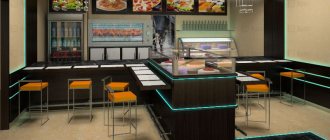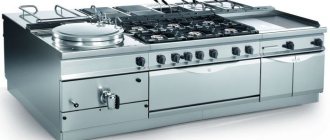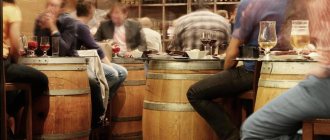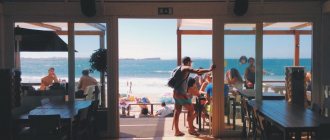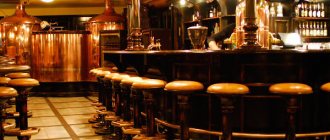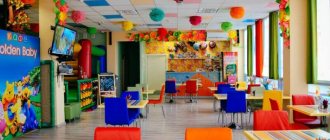Organizing the effective operation of any catering enterprise is not difficult. By efficient work, we mean, first of all, profit (organizing a turnkey restaurant - I opened it in the morning and everything works like clockwork again). So, in order for an enterprise to be profitable, it is enough to achieve several goals:
- The company's expenses correspond to its income;
- The offer corresponds 100% to guest demand;
- Operational budgeting has been implemented and is in effect;
- Production technology ensures its stability;
Choosing a restaurant concept
In a highly competitive environment, you need to stand out. Your task is to offer visitors something that no one has ever offered before. And here we are not necessarily talking about an exotic menu or spectacular decorations. You can hook a client with convenient service, attractive offers, and additional services.
How to choose a concept? Three key questions need to be answered
- Who is the visitor to your establishment?
- Where is the restaurant located?
- What might attract your target audience?
The concept of the establishment is as important as the food in it. It includes not only the choice of direction (pizzeria, Chinese restaurant, youth cafe, coffee shop), but also such characteristics as: corporate identity, design project, philosophy of the establishment, atmosphere, visitor portrait, features that will distinguish your restaurant from many others.
By the way, you can entrust this stage to specialists. Today in the restaurant business, the service of developing an establishment concept has been developed. Specialists will help you not only develop a corporate identity and design, but also solve organizational work on designing, repairing and equipping a restaurant. Such services will greatly simplify the preparation process, but will “eat up” a considerable chunk of your budget. On average, for an establishment with an area of 100 sq.m. will cost 400-500 thousand rubles.
What you need to start
A restaurant is a serious undertaking. Its main advantage is its difference from other similar institutions. Therefore, you need to create your own idea. It is recommended to consider the following:
- The trademark of an enterprise, that is, a special feature.
- Starting from the highlight (the main difference of the restaurant), you need to develop an interior design.
- The next stage is personnel selection. Personnel must:
- correspond to the chosen feature of the restaurant;
- have the appropriate qualifications;
- sometimes even people's appearance and temperament are important.
- An important step is the selection of dishes (menu development). The list of treats should be:
- harmonious;
- compatible with the chosen idea;
- acceptable to clients.
- The previous stage is related to suppliers:
- they need to be found;
- conclude contracts;
- develop an interaction style, etc.
Help: all the steps described above together are called developing an enterprise concept.
What are the types of restaurant business enterprises?
There are a great many gastronomic organizations. A novice restaurateur needs to choose one in order to develop a further development strategy. Companies are like this:
- Restaurant. This is a catering establishment that has a feature or personality. It is different:
- expensive interior;
- non-standard design and gastronomic solutions;
- high level of service;
- originality of the atmosphere.
- Cafe. The establishment is simpler. Customers value cafes for the opportunity to have a quick, inexpensive and tasty meal. Services for the sale of ready-made takeaway meals are welcome.
- Bistro. Such an establishment must offer food and drinks appropriate to the time of day. Its peculiarity is its unpretentiousness and simplicity of atmosphere.
- Coffee house. A small and cozy establishment. Specializes in coffee (by name), tea and desserts.
- Confectionery. About the same as a coffee shop. But the establishment's specialization is aimed at satisfying children's and family needs.
- Bar. A company aimed at an adult clientele. Specialization is associated with a large selection of strong drinks.
- Fast food. Such a catering establishment is aimed at a large flow of visitors. Meals should be planned simple, nutritious, and inexpensive.
- Dining room. It is advantageous to open such an enterprise near educational institutions or large enterprises. The kitchen should be simple, homely.
- Sushi bar. This is what Japanese restaurants are called. To open one, you need a specialist in making sushi.
Advice! The type of establishment must be selected based on the potential clientele.
Criteria for selecting a location for an establishment
To be successful, a restaurateur needs good premises. Experts suggest relying on the following selection criteria:
- Location:
- in the first line of buildings;
- at the intersection of streets;
- close to potential clientele.
- Requirements:
- two entrances (technical required for product suppliers);
- appropriate size;
- on the ground floor or in a separate building;
- the room must correspond to the concept (for a bar, for example, a semi-basement room is suitable, and for a coffee shop - a basement).
- Methods for acquiring the right to use:
- purchase (requires large investments);
- rent (provided for a certain period of time with the possibility of extension).
Hint: usually unprofitable premises are sold. Before concluding a purchase and sale agreement, it is advisable to study its history.
Making a business plan for a restaurant
Once you have decided on the idea and concept, you need to draw up a business plan. It will allow you to avoid unnecessary expenses and mistakes at the start, estimate the amount of work, and determine the time and financial framework of the project. The business plan should answer the following questions:
- What items will be on the menu?
- How much money does it take to open a restaurant?
- What equipment do you need to purchase?
- How many employees will need to be hired?
- How much can you earn?
- How to advertise your establishment on the market?
Thus, a business plan is a kind of model of your institution, which will allow you to determine the algorithm of actions for implementing the project and the resources that will be required for this. You will calculate key business indicators:
- Initial investment;
- Revenue;
- Monthly expenses;
- Net profit;
- Payback period.
When writing a business plan, one of the most common questions is how to plan for profit. Calculating expenses is a little easier. Practice helps. But income has to be calculated in advance. And here it is important to get real amounts. The public catering market is a specific business where it is not so easy to calculate the level of income. This indicator depends on many factors. Therefore, the assessment of restaurant income is quite subjective and is based on the indicators of other establishments. But for you, these amounts will be a guideline, and not a guarantee of earnings. Since profit planning is akin to fortune telling on coffee grounds, it is usually customary to draw up three scenarios for the development of events - negative, positive and the most expected.
Profit calculations can be made based on the number of seats, average check, occupancy level and average length of stay in a restaurant, but the results can be very inaccurate. It is most prudent to visit several competitors' establishments of a similar price category and count their customers on weekdays, on weekends and holidays, during the day and in the evening, and then average them out. Of course, you don’t have to be present inside the restaurant to do the calculations, and even around the clock. Calculations can be done, for example, from a car with a calculator in your hands and a multiplication table in your head. This study will help you get rid of unnecessary illusions and predict real numbers.
You still won’t be able to earn much in the first months, so when planning your budget, be sure to provide a financial cushion to cover current expenses in the initial stages. An active and competent advertising campaign will speed up the process of finding clients. Try to launch promotion in advance to attract the first visitors by the time of opening.
Stage No. 3. Purchase of equipment, furniture and utensils
At the stage of purchasing kitchen equipment, it is recommended to already have a chef, since he is the one who is able to draw up a complete list of everything that is necessary for the kitchen, taking into account the proposed menu. Dishes and serving items, furniture - all this can be selected independently, taking into account the developed concept and interior, but buying something for the kitchen without taking into account the opinion of the chef is stupid. Please note that the total number of cutlery and dishes should exceed the maximum number of seats by 2-3 times.
Make purchases from specialized companies that supply professional equipment and tableware to restaurants. Such companies offer their products at wholesale rather than retail prices, provide a guarantee on all equipment and perform warranty repairs if necessary, and will also be able to supply you with completely identical dishes in the shortest possible time to replace broken or lost ones.
Furniture arrangement is also carried out with the help of designers who will offer you the most suitable solution for the interior.
We collect permitting documentation
Opening a restaurant is one of the most difficult types of business in terms of collecting documents. Therefore, you need to stock up on patience, strength and money. Budget 15-20 thousand rubles for completing all documentation.
First you need to register your business with government agencies. The most convenient and common form for restaurants is considered to be the “LLC” form. Type of activity according to OKVED-2 classification:
- 56.10 “Activities of restaurants and food delivery services”
- 56.10.1 “Activities of restaurants and cafes with full restaurant service, cafeterias, fast food and self-service restaurants.”
All permitting documentation must be completed. It is necessary to collect the following package of documents:
- OGRN certificate;
- safety magazine;
- TIN certificate;
- finishing certificates with the necessary SES requirements;
- sanitary and epidemiological conclusion issued by Rospotrebnadzor;
- documents for checking instrumentation and measuring utensils;
- agreements with SES and fire service;
- conclusion of the tax inspectorate on registration of cash registers
- agreement with the energy saving service and sewerage service;
- agreement with the residential complex for waste removal;
- agreement with the tenant and agreements with employees
- assortment list approved in the SEN
- a license to sell alcohol, if it is intended to be sold in the establishment
Please pay attention to the requirements specified in these documents. This information will be useful when choosing a room and organizing the work process. It is better to immediately take into account all the requirements so that you do not have to correct inconsistencies in the future and spend money on it.
Important nuance! If a restaurant intends to include alcoholic beverages on its menu, a license is required. The license is issued for a period of 1 year if the establishment complies with the following requirements:
- a room larger than 50 sq.m.;
- availability of necessary communications - plumbing, electrical wiring, heating;
- distance of at least 100 meters from educational, medical and sports institutions.
According to amendments to Federal Law No. 261-FZ dated July 3, 2016, from March 31, 2020, public catering establishments selling alcoholic products must obtain a license for each type of activity: retail sale of alcohol and trade in alcohol when providing public catering services. The total cost of the license will be 130,000 rubles. You can read more about obtaining permits for a restaurant here.
The first stage of opening a cafe from scratch: registration of an individual entrepreneur or LLC
In a business plan for opening a cafe, the form of ownership must be indicated. Business registration documents are submitted to the tax service. They register a business on their own or contact a specialized company. In the second case, the procedure will be performed by qualified lawyers.
A simpler option is to register an individual entrepreneur. In this case, the entrepreneur is liable with his personal property. The registration process includes preparing a package of documents for opening a cafe: copies of passports, a completed application and a receipt for payment of the state duty. An individual entrepreneur has the right to use earned funds for any purpose and not maintain strict reporting.
For individual entrepreneurs there are restrictions on areas of activity. One of them is the production and sale of strong alcoholic beverages. An LLC has no such restrictions.
To register an LLC, a legal address is required. The list of documents for opening a cafe includes an application, a decision on establishment, a charter, and a receipt for the transfer of state fees. Be sure to contribute an authorized capital of at least 10 thousand rubles. The LLC maintains strict financial and tax reporting.
Search for premises for a restaurant
Finding suitable premises for a restaurant is not so easy - difficulties are created by the many requirements, norms and restrictions that apply to them. Therefore, the search must begin in advance. Try to find the premises where the catering establishment was previously located. In this case, you will save on bringing the premises into compliance with the standards. Moreover, you will save not only money, but also time. In addition, such premises are sometimes rented with some equipment: exhaust hood, ventilation, air conditioning system.
When choosing, you should pay attention to two parameters: the location and the condition of the room itself.
The location for the future restaurant is selected taking into account the concept. For example, it is better to place a youth cafe near educational institutions, and a family cafe in a residential neighborhood. An incorrectly selected location can leave a restaurant without visitors.
Evaluate the location using services such as Yandex.Maps, Google Maps, 2GIS. This way you will find out whether your direct competitors are nearby, whether your target audience can be met there, and how convenient the transport interchange is so that the visitor can drive up to the establishment.
Assess the premises: does it meet regulatory requirements, is there a possibility of redevelopment, is renovation required, are there all the necessary communications... Also pay attention to the electrical capacity, since food equipment consumes a lot of electricity.
Basic requirements for the restaurant premises:
- square area about 100 sq. m.;
- the presence of artificial and natural ventilation;
- availability of sewerage;
- availability of additional rooms (storage room, bathroom, staff room).
- More detailed requirements for the premises are set out in SanPiN.
One of the most important issues at this stage is the cost of rent. A restaurant will require a considerable area, and not every entrepreneur has the opportunity to purchase premises as their own. The rental rate depends on various factors: in which city or district the premises are located, pedestrian traffic, and favorable proximity to other public institutions. On average, renting a premises will cost 80-150 thousand rubles monthly. Experienced entrepreneurs recommend paying for six months at once - then by the time you make the second payment you will already have time to get started.
What restaurant should I open?
To open a restaurant correctly, carefully consider the concept of the establishment.
Price level
Determine the initial budget, on which other parameters will depend. The price level directly depends on the status of the restaurant: in an establishment in the city center with its own parking and terrace, with a famous chef and first-class service, with a unique designer renovation, the prices on the menu will be much higher than in a small cozy beer restaurant near the metro.
A restaurant as a format in itself requires a demanding audience and large investments. At the same time, in one establishment the same “hot” classic Caesar salad will cost 120 hryvnia (200 rubles), in another - about 250 hryvnia (400 rubles). However, experts do not recommend that newcomers to the catering industry start with financially expensive establishments. Large investments may not pay off due to the inexperience of the owner.
Kitchen type
Japanese, Ukrainian, Italian, Georgian, European and so on. The interior of the establishment and its location depend on the type of cuisine. To open a successful restaurant from scratch, it is better to choose a cuisine in which you are well versed. Otherwise, monitoring and managing the restaurant will be quite problematic.
Maximum number of guests
To begin with, you should limit yourself to 30–70 seats, otherwise the cost of arranging the establishment will cost a decent amount. The ideal option would be a room with the possibility of placing a summer area to increase planting during the season.
Open an Italian restaurant
The main differences between opening an Italian restaurant and an establishment with any other cuisine are the peculiarities of menu composition, interior design and bar menu.
The menu should include both popular items - pasta, pizza, lasagna, risotto - and rare national Italian dishes that would set your restaurant apart from its competitors. These could be cacciucco or minestrone soups, main courses - polenta, gnocchi, dishes with the addition of truffles, and so on. Particular attention should be paid to desserts - tiramisu, cannoli, sabayon, panna cotta.
The bar list in an Italian restaurant consists mainly of different types of wine that correspond to certain menu items. Wine should further reveal the taste of the dish and complement it. It is also worth focusing on the financial capabilities of the target audience.
Italian style in the interior of a restaurant is the main color white, natural shades, soft lighting, wooden furniture. It is also important to remember about beautiful little things: paintings with seascapes on the walls, elongated tall vases, forged elements. A good addition would be decorative niches and shelves with wine.
Open a Japanese restaurant
Japanese restaurants have become quite popular lately, so it is not surprising that new establishments of this format are opening every year.
A huge advantage of a Japanese restaurant over competitors with a different menu is the large number of takeout and delivery orders.
If you haven't yet thought through the concept of an establishment or don't know where to start, look through the available franchises. This will provide brand recognition and help from a successful company at the stage of building a business, so this is a good option for developing your own business.
If you want to be different from existing establishments, you need to think through the interior and menu. The interior decoration of a Japanese restaurant is laconic, without unnecessary details, so the huge costs at this stage of opening the establishment will be slightly less.
The kitchen can be located in a small area; open kitchens are popular, where guests can watch the process of preparing sushi and rolls, which form the basis of the menu. Sashimi, salads, soups and desserts are in less demand.
How to open a beer restaurant
The concept of a beer restaurant differs from pubs, because the restaurant focuses not on imported draft beer in kegs, but on an elite craft drink. It is best to open a beer restaurant if you have your own brewery or an agreement on permanent cooperation with local craft breweries.
The menu of a beer restaurant includes a variety of beer snacks and full meals, which also depend on the concept of the establishment. If German beers are served, then the appetizers should be appropriate: Bavarian sausages, pork knuckle, pretzel, cheese, stewed cabbage, and so on.
The interior plays one of the main roles in the concept of a beer restaurant. If you decide to give up a franchise in order to create a unique establishment, you need to carefully consider the interior environment. There is a large selection here: industrial design, loft, art deco, rock and roll and much more.
Purchase of equipment and furniture
The quality of a kitchen's equipment and tools determines its production capacity and even affects the taste of food. Therefore, you should approach your choice responsibly. Study in advance the offers on the restaurant equipment market, reviews of equipment and the experience of other entrepreneurs. You can also use the services of companies that organize restaurant business.
The list of necessary equipment may vary because it depends on the menu. For example, high-quality ovens are important for a pizzeria, a special rice cooker is important for a sushi bar, and deep fryers are important for a fast food establishment.
But we can highlight the main categories of equipment that will be needed in every kitchen:
- oven and other equipment for heat treatment: ovens, deep fryers, stoves, etc.;
- refrigerators, freezers, refrigerated countertops and vacuum sealers for food storage. The model of refrigeration equipment must be selected depending on the layout of the kitchen and the list of stored products;
- dishwasher to automate the process and disinfect dishes;
- equipment for preparing drinks: juicer, coffee machine;
- electrical appliances: mixers, blenders, food processors;
- kitchen utensils and other small equipment (knives, food containers, stands, containers, etc.);
- equipment for dough: dough mixers, sheeters, molds, etc.
Equipment costs may also vary. On average, the basic equipment of a regular restaurant will cost 300 thousand rubles. To reduce this list and save money, you can shorten the cycle of manufactured products and purchase ready-made semi-finished products. For example, bakery products can be purchased from a bakery, and cakes from a pastry shop.
In addition, you will need to purchase furniture and other equipment, including a bar counter, tables and chairs, a cash register and a cashless payment terminal, and decorative items. And this is about another 350 thousand rubles. This amount will increase if it is necessary to install an alarm system, air conditioning and ventilation systems.
How to choose the right staff for a restaurant?
A cook, bartender and waiter are required. And then it all depends on the owner, whether he is ready:
- clean and wash the dishes yourself if one of the dishwashers does not come out;
- running around with documents instead of a manager, accountant and lawyer;
- handle all holidays, corporate events and banquets instead of the administrator;
- invite and seat guests, as a hostess does, etc.
Today we employ 23 people, but we are looking for more employees and are glad to see new hardworking and pleasant people in our team.
The guys themselves form shifts as they feel comfortable, on average 8-12 hours, depending on holidays, weddings and banquets. We have a clear distribution of responsibilities, but there are also various seasonal and holiday additions. For example, in the summer one of the administrators is responsible for the flowers on the terrace, and at night all the flower beds are watered by security until all the staff leave. During the holidays, a different administrator is responsible for all the decor, etc.
Irina Prytkova, owner of the Stafilye restaurant
I can only add that the minimum staffing directly depends on the number of seats. But what is important is not the number of employees, but their quality, professionalism and responsibility.
Dmitry Kazantsev, owner of the Podvorotnya restaurant
Basic rules when recruiting personnel for an institution:
- An applicant for any position in a restaurant should be neat, because this shows how he will treat his workplace. If the applicant comes in with rumpled clothes or dirty shoes, it means that he will work with incomplete dedication and sloppiness.
- Waiters, hostesses, and bartenders should be sociable, courteous and friendly.
- Knowing English will be a good bonus to communicate with foreign visitors.
- Both senior and junior staff must first of all be patient and stress-resistant.
- A hostess is selected based on two criteria: external appearance and knowledge of foreign languages.
Typically, in large institutions, personnel selection is carried out by a senior manager or manager. To improve the skills of staff, they need to be constantly trained and tested for knowledge of their direct responsibilities.
Restaurant staff
It is very important to find qualified employees, because the reputation of your establishment depends on their work. Careful selection should be applied not only to the chef, but also to all other staff. Restaurant employees must form a coherent system in which each participant has clear duties and responsibilities. We begin our search by choosing a chef. Finding a good chef is quite difficult because qualified specialists are usually busy. Posting an ad on a website and simply waiting for a good specialist to call you is wrong. You need to look for a chef purposefully: in other establishments, at master classes or through a restaurant recruitment agency. If you have no experience in catering, a chef can also become a key advisor on kitchen equipment. Often the very idea of opening a restaurant begins with the chef. It happens that entrepreneurs “import” this person from afar, inspired by his cooking on a trip abroad. In this case, you always need to remember the native realities: will this chef also be successful without supplies of the freshest seafood and exotic fruits and vegetables.
Waiters are no less important. It is better to train good employees yourself; conduct regular trainings for them, send them to master classes, form a team and motivate them to achieve results. Lack of motivation reduces the quality of service, and this will lead to an outflow of visitors. So saving on employee salaries can lead to a significant loss of revenue.
On average, the salary of cooks is 40-50 thousand rubles. Waiters - about 20-25 thousand rubles. Please note that you will have to organize two work shifts in order to comply with labor laws. For a new and not yet promoted establishment, it will be enough to hire two cooks, four waiters-cashiers, a manager and 2 dishwashers and a cleaner. With such a staff, the payroll will be about 250 thousand rubles (including social contributions).
Stage No. 5. Recruitment
If your budget allows, you can contact a recruiting or staffing agency, whose specialists can handle the issue of personnel selection. But for a small establishment it is quite possible to do it on your own. First of all, you should hire a chef, and this should be done at the stage of approving the final concept, since he must be involved in the creation of the restaurant. In addition, an experienced chef will probably give you a couple of useful ideas.
Cooks and bartenders should be selected together with the chef to ensure their professional skills. For administrators and waiters, a resume and work experience is required, and to hire support staff (dishwashers, cleaners, etc.), an interview is sufficient.
The number of staff that should be hired directly depends on the format of your restaurant/establishment and its size. If we consider a small restaurant with affordable prices, then the approximate composition of the staff is as follows:
- Kitchen. Chef and two shifts of cooks of 2-5 people;
- Two bartenders with barista skills.
- Hostess/administrator.
- Two shifts of waiters of 3-6 people each.
- Buyer;
- Two shifts of support staff (cleaning lady and dishwasher).
- Accountant. Here you can save money and turn to the services of a freelance accountant or outsource this position.
Restaurant menu
Menu development is a very important stage when opening a restaurant. The menu must correspond to the concept not only in content and originality, but also in price. If you position yourself as an affordable cafe, then the prices should be appropriate.
When creating a menu, consider the following nuances:
- provide consumers with variety. Add new items or special seasonal offers to the menu. This will help retain regular customers;
- Be guided by prices in other establishments. This is perhaps the most important factor in pricing policy. The vast majority of customers do not care about the cost of food. Today they use the formula “all the best - for reasonable money.”
- make a technological map for each dish. Be sure to indicate the food consumption per serving and its volume. This data is needed for SES and calculation of the required raw materials;
- Follow the principle of complete and variable use of products. This will reduce the risk of food spoilage if a particular dish is unpopular;
- Be sure to take into account consumer preferences. Track your order history to identify your most popular and unpopular items. The most popular items can be slightly increased in price over time. It is better to exclude unpopular dishes or replace them with analogues. Also remember that it is advisable to complement the computer analysis of demand for many dishes with a visual one - at least occasionally look at the sink to find out what is most often left on the plates.
Stage No. 6. Menu creation and supplier selection
Menu development is usually done at the final stage of concept approval. At this point, you should already have a chef, because you should only approve the menu with him. In general, the menu is created by the chef himself, and the owner only approves it, focusing on the cost of ingredients, attractiveness and taste.
It is up to either the restaurant manager or the buyer to select suppliers. You should conduct a market analysis and select the most optimal companies in terms of price and quality, and it is not necessary to choose only one supplier. It is much better and more reliable to consider individual suppliers for each product group, and also have contacts of backup suppliers in stock. This is especially true for expensive and exotic products, the delivery of which may be problematic.
Supply and suppliers
Before opening a restaurant, you must decide on suppliers and arrange supplies. The main requirement for suppliers is timely delivery of high-quality and fresh products. Please note that all products must comply with GOST requirements and have quality certificates.
To calculate how many products need to be purchased, you will need a technological map and a sales forecast. Of course, you won’t get an exact indicator, but in the process of work you will determine the optimal purchase volume.
Take your time to conclude an agreement and arrange the delivery of products. To get started, carefully study different cooking technologies, offers from different suppliers, etc.
The list of necessary products for purchase is individual for each establishment. But there are categories of suppliers with which every restaurateur cooperates:
- fresh meat suppliers;
- fresh vegetable supplier;
- suppliers of dairy products (sour cream, cream, cheese, etc.);
- suppliers of various sauces, spices, etc.;
- tea/coffee/drink suppliers.
Of course, it is easier to work with a comprehensive set of suppliers who can supply you with all the products you need. Such suppliers offer a flexible system of discounts, guarantee fast deliveries and generally make life easier for the restaurateur by eliminating unnecessary paperwork. But in Russia, finding a reliable integrated supplier is not so easy. A complex supplier is less flexible and loyal to its customers. He cannot adapt to the different requirements of all his clients, and in this he loses to small suppliers.
The main advantage of small suppliers who supply certain products is that they are ready to take into account the needs of each client and work with him individually. Typically, small companies monitor the quality of the product more seriously and understand it well. And individual suppliers also have a larger selection of products.
Which supplier to choose - a comprehensive one or several small ones - is up to you. But before you make a final decision on cooperation, analyze the proposals. Make your first purchase small, order small quantities from different suppliers to compare the quality and choose the most successful option. In the future, make purchases often, but in small quantities. This will provide your establishment with fresh products and simplify their storage.
When signing an agreement with suppliers, be sure to read all the conditions specified in the documents. For example, transport costs are usually covered by the customer, that is, you. Therefore, whenever possible, choose those suppliers that are closer to your establishment. This way you will reduce shipping costs. Also, pay attention to what guarantees the supplier provides. Discuss what responsibility the parties have if delivery, payment or product quality deadlines are violated. You can read more about the practice of relationships with restaurant suppliers in this article.
How did you create the menu and who set up the technological process for you?
I created the first menu of the restaurant myself, based on my vision of the restaurant. At the time of opening, we had six different chefs, and my husband and I relied only on ourselves. Now we have a wonderful chef, he slightly adjusted my menu, introduced his signature dishes and set up the entire technological process. I abandoned this idea because the costs were not comparable to the results.
Now we have a completely new menu coming out from Oleg Marakhovsky, whose authorship I certainly do not claim.
Irina Prytkova, owner of the Stafilye restaurant
We were very lucky to have a chef who came before the establishment opened and is still working with us. The task before him was not an easy one: to reproduce dishes from Elena Molokhovets’ 1909 cookbook, using modern ingredients. He coped with the task perfectly, but over time he had to rebuild the menu to take into account more standard demand.
Dmitry Kazantsev, owner of the Podvorotnya restaurant
Accounting system on a tablet
Connect Poster to maintain detailed warehouse and financial records
Restaurant advertising launch
First you need to draw a portrait of your target audience. Based on this, build an advertising campaign. After all, different audiences need different advertising. For advertising to be effective, it must fully meet the needs of the audience. It is important to know the interests of your potential consumers not only in order to choose advertising methods, but also to design the advertising material itself: text, video, flyers, etc.
Approximate advertising costs:
- outdoor advertising: sign, including installation – 30 thousand rubles;
- advertising on social networks, account promotion, page administrator services – 30 thousand rubles (can be done independently);
- Conducting a competition (for example, a repost competition, “tag a friend”, etc.) with a drawing of certificates - 3 thousand rubles.;
- Creation and printing of advertising material (business cards, flyers, etc.) – 10 thousand rubles.
So, on average, the cost of an advertising campaign will be 73 thousand rubles. The size of your advertising budget depends on how much money you are willing to spend on it. It’s better not to skimp on promotion, but spending a lot of money is not a guarantee of great success. You must have a marketing strategy, according to which you will determine an effective set of advertising tools and optimize your costs. Promotion should be especially active in the first months of the establishment’s operation so that you immediately attract the attention of consumers.
But do not forget that the best advertising for a catering establishment is word of mouth. It's free, effective, and yet not easy. After all, in order for your establishment to be recommended, you must provide a high-quality product and service. If the consumer appreciates the dishes and service, he will want to return and recommend the establishment to his friends. In addition, regularly monitor trends and new business ideas in the food service industry. The age of restaurants today is short-lived; any concept quickly becomes boring.
Stage No. 7. Advertising
The advertisement is engine of the trade. Therefore, if you want to get a stable flow of clientele, you should advertise your establishment. The following advertising techniques are commonly used:
- outdoor advertising at the establishment (signboard, lighting design)
- outdoor advertising in accessible proximity to the establishment (signs, banners, billboards);
- distribution of booklets, flyers, leaflets;
- social networks and specialized catalogs;
- advertising in the media;
- own website.
An advertising campaign should be launched not before the restaurant opens, but 1-2 weeks before. The format of an advertising campaign directly depends on the format of the establishment and the target audience, so it is better to consult with a marketer or advertising specialist.
How much money does it take to open a restaurant from scratch?
The table shows the approximate amount of initial investment. Please note that a “reserve fund” has been added to the expense items. What it is? This is an amount that will serve as a financial cushion for you in the first months of operation, when the restaurant is operating at a loss. After all, in any case, you will have to pay wages to your employees and cover other expenses for uninterrupted work (utilities, purchasing products, etc.).
Calculation of initial investment
| № | EXPENDITURES | AMOUNT, RUB. |
| 1 | Rent of premises (for 6 months) | 500 000 |
| 2 | Redecoration and room design | 100 000 |
| 3 | Legal registration and permits | 150 000 |
| 4 | Equipment and inventory | 650 000 |
| 5 | Purchase of products | 80 000 |
| 6 | 70 000 | |
| 7 | Other expenses and reserve fund | 300 000 |
| Total: | 1 850 000 | |
Thus, opening a restaurant will require about 2 million rubles.
Financial questions
To start a restaurant business, you should calculate all the initial costs in advance. These include:
- purchase of equipment;
- renovation of premises;
- purchase of furniture and kitchen utensils;
- renting or purchasing premises;
- purchase of food and alcoholic beverages;
- employee salaries and other expenses.
In order not to stop halfway, you need to calculate in advance how much you will have to spend on all these items.
There is no need to save money on purchasing furniture and equipment
Restaurant income and expenses
There are no exact figures on the level of profitability of restaurants - there are too many variable factors. But some guidelines still exist. In most restaurants, more than 55% of the costs of revenue come from just three expense items:
- Products.
Most often, 25 to 35% of revenue is spent on the purchase of raw materials.
- Rent
. For small cities it can be about 15%, for large cities - 20-25% of turnover.
- Staff.
Employee costs are usually in the range of 20-25%.
The rest comes from a whole range of costs, including utilities, taxes, equipment repair and maintenance, purchasing detergents, waste disposal, advertising, software updates and maintenance, and much more. Each of these costs individually does not carry a large financial burden, but together they can eat up the lion's share of income. The entrepreneur's task is to prevent this from happening.
What should be left from the proceeds? In other words, what is the normal profitability of a restaurant? Today, the usual figures are 10-20%. This means that, for example, with a restaurant’s revenue of 800 thousand rubles, a “good” net profit is 160 thousand rubles, and 300 thousand rubles of revenue is normal with a turnover of 1.5 million rubles. Accordingly, indicators below 10% indicate that the establishment is at risk, and more than 20% indicate a more stable source of income. Today it is difficult to call the restaurant business extremely profitable.
What kind of traffic and average bill did you expect to achieve in the first six months, year?
In fact, we did not have such calculations. It was pure experimentation. Studying the experience of other restaurateurs and relying on the cost of dishes in establishments in approximately our price segment, we really wanted to achieve self-sufficiency in at least a year, and now we are already at the finish line towards our goal.
Irina Prytkova, owner of the Stafilye restaurant
When opening the establishment, we took into account the classic indicators of occupancy of seats and the average check, but the launch of the restaurant took place in September 2013, two months before the sad events on the Maidan. As a result, we did not achieve the planned results due to force majeure, but overall we managed it quite confidently, the process just dragged on.
Dmitry Kazantsev, owner of the Podvorotnya restaurant
Analyzing risks
Preventing risks is easier and cheaper than eliminating their consequences. Restaurants are among the leaders in the number of bankruptcies. Therefore, be sure to think about what threats there are in your business and how you can minimize them.
We list the main risks of the restaurant business and ways to neutralize them:
- bad choice of location.
For a catering establishment, location is both a method of promotion, part of the concept, and a factor of business reputation. If you choose the wrong location, you risk low revenue. Therefore, take a responsible approach to the analysis of the outlet and take into account various factors. Separately, familiarize yourself with the specifics of opening a restaurant in a small town and a cafe near the highway.
- rising prices for raw materials, unscrupulous suppliers, low-quality raw materials.
This risk may lead to increased costs, operational disruptions and a decrease in the establishment's reputation. To reduce the likelihood of risk, you should carefully select suppliers, include in supply contracts all the necessary conditions that imply financial liability of the supplier if they are not fulfilled;
- reaction of competitors.
The food service market is quite saturated, so the behavior of competitors can have a profound impact on your business. Some will reduce prices, others will launch a profitable promotion, others will copy your idea... There can be many options, and you are unlikely to be able to protect yourself from all competitive tricks. But to reduce this influence, you need to build your customer base, constantly monitor the market, offer loyalty programs to your customers, come up with unique offers and always work to improve your competitive advantages;
- problems with personnel
(low qualifications, staff turnover, theft among staff, lack of employee motivation). This risk is dangerous because it entails a decrease in profits, an increase in costs and even the formation of a negative image of the establishment. To avoid this, you should install automation of all production processes (control of orders, products in the warehouse, etc.), a control system, piecework payment. It is important to create comfortable, favorable working conditions for staff;
- problems with equipment, production downtime.
Kitchen equipment breaks down. And if this happens, you must troubleshoot quickly. There should be no production downtime in the restaurant business. To reduce the risk, you need to carry out regular maintenance. maintenance and testing of equipment, cooperate with a process engineer who, in the event of equipment breakdown, can quickly solve this problem;
- food spoilage due to low demand, breakdown of storage equipment, improper storage, planning errors.
Proper planning of the volume of purchases is a very important part of the work. You can lose significant amounts simply because you incorrectly calculated the volume of required products. If you count too much, the food will spoil. If you buy little, some items from the menu will be unavailable, and you may lose part of the profit. Therefore, you need to carefully plan the volume of required products, based on indicators of past periods, and monitor the condition of refrigeration equipment.
- decrease in the reputation of the establishment.
Since the restaurant business is so dependent on word of mouth, you must maintain a good reputation at all times. Errors in management, poor service and poor quality food can ruin your reputation and lead to losses. To reduce risk, establish constant monitoring of product quality and feedback from customers of the establishment in order to correct errors in a timely manner.
You can read more about the pitfalls of the restaurant business here.
Enterprise expenses correspond to income
Running a restaurant depends very much on how you spend the proceeds. Most people have the following errors in this direction:
- They buy more than they sell
- Paying employees more than they actually earn
- Motivated by what employees don’t need
- They teach those who already know everything
- Can't turn expenses into investments
Modern management systems will help you get rid of these errors: Sales orders, piecework wages, unsystematic motivation and others.
